Transcript of press conference JIT MH17 on 8 February 2023
On this page you can read the full transcript of the press conference of the JIT MH17, held in The Hague on February 8th, 2023, including the media that was presented.
Good morning,
We are meeting here today to update you, possibly for the last time, about the criminal investigation into the downing of flight MH17. This summer it will be nine years since 298 passengers lost their lives. As in previous years, we stand here together as members of the Joint Investigation Team (JIT). We would like to thank Eurojust, as the JIT’s dedicated partner, for facilitating this event.
In 2016 and 2018 we told you about how the MH17 disaster came about, and in 2019 we explained that three Russians and a Ukrainian were suspected of being responsible for the downing of the aircraft. In July 2014 these men were military leaders of the so-called Donetsk People’s Republic, the DPR. On 9 March 2020 the criminal trial of these four defendants began in the Netherlands. On 17 November 2022 The Hague District Court found three of them – Igor Girkin, Sergei Dubinskiy and Leonid Kharchenko – guilty of downing flight MH17, resulting in the deaths of all 298 persons on board, and the murders of those persons. The court sentenced the three men to life in prison. The fourth defendant, Oleg Pulatov, was acquitted. No appeal was lodged against these judgments.
In addition to considering the culpability of members of the DPR, the JIT conducted a wide-ranging investigation into the crew of the Buk TELAR and the parties responsible for providing the weapon. To this end the investigation team issued various witness appeals, and in 2021 it launched a media and letter campaign, aimed at residents of Kursk and members of the 53rd Anti-Aircraft Missile Brigade (AAMB). Various witnesses were interviewed, including members of the 53rd AAMB. In addition, the team reviewed a large number of intercepted phone conversations and other telecom data. It also investigated satellite images, gathered information about military radar systems, conducted covert investigative activities with the authorisation of the examining magistrate, and examined both public and classified sources in depth. The JIT also received information from the European Space Agency and the Netherlands Defence Intelligence and Security Service (MIVD).
The investigation has now reached its limit: all leads have been exhausted. The investigation is therefore being suspended. At the present time the findings are insufficient for the prosecution of new suspects. We will be making the findings of the investigation public. That is the purpose of the presentation for the next of kin, this press conference, and the report that will be published today. In this way we are complying with our national and international obligations to keep both the next of kin and the public at large informed. This information may also be relevant to the ongoing state responsibility proceedings.
We will now present a summary of the report. We will be sharing the main findings of the investigation into the crew, their superiors and the parties responsible for providing and deploying the Buk TELAR. For reasons of security and privacy, we are not able to release all the information uncovered in the investigation. This decision is also motivated by the possibility of further investigation and future prosecutions. We will not be mentioning any individuals by name, except for public figures or in cases where the relevant names have already been made public. All of them should be considered innocent until a court finds that the reverse has been proven.
We will start with the further investigation into the origin of the Buk TELAR that was used to shoot down MH17 and the crew members and their superiors. We will then discuss those responsible for supplying the weapon system, and finally we will turn our attention to the parties involved in the deployment of the Buk TELAR.
This presentation is based on the facts established by the court in its judgment of 17 November. Specifically, the court held that:
- as of mid-May 2014, the Russian authorities exerted far-reaching control over the conflict being waged by the DPR;
- the Buk TELAR used to shoot down MH17 came from the Russian Federation, complete with a crew;
- everyone who made a contribution to the deployment of the Buk TELAR bears responsibility for the downing of MH17;
- the exact actions of the crew during the launch of the Buk missile at MH17 are unknown, nor is it known who gave the order to fire;
- to this day, the Russian authorities continue to deny any involvement in the conflict in eastern Ukraine and they have presented falsified evidence on multiple occasions.
The court also concluded that the images of the Buk TELAR captured in Ukraine on 17 and 18 July 2014 are authentic. As a result, they could be used for identification purposes. As the JIT has previously explained, this Buk TELAR has 15 specific features. A Buk TELAR with the same features was found to be part of a Russian military convoy, originating in Kursk, which followed a southerly route along the Russian-Ukrainian border from 23 to 25 June 2014. We call it Buk TELAR ‘3X2’ because of the markings on its left side. The JIT was able to establish that this weapon system was from the Russian 53rd Anti-Aircraft Missile Brigade in Kursk.
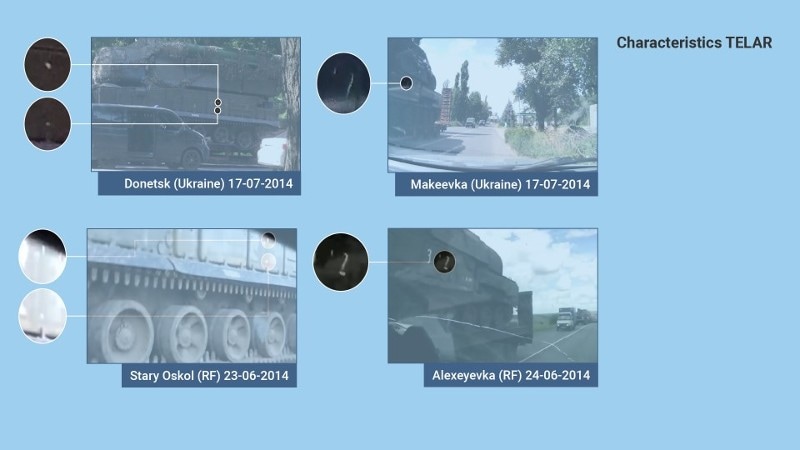
In order to determine why flight MH17 was shot down, an investigation was conducted into the identity of the crew and their superiors. After all, they should be able to answer that question. A complicating factor was the absence of any telecommunications involving the crew. The telephone number which the court attributed to a crew member was active in Ukraine only on 17 July. This number was not tapped, nor was it in contact with any numbers that were tapped.
This is why we first looked at the composition and organisation of the 53rd Brigade, which consists of approximately 700 people: conscripts, contract soldiers and officers. In 2014 the 53rd AAMB consisted of a staff and communications company, a technical support company and three operational battalions. Each battalion has a full Buk system consisting of 11 Buk vehicles: a command vehicle, a radar vehicle, three launch vehicles without radar (the TELL), and six launch vehicles with radar (the TELAR). A battalion is led by a commander and his deputy, and has its own staff. Each battalion is divided into three companies. A company consists of two TELARs and one TELL.
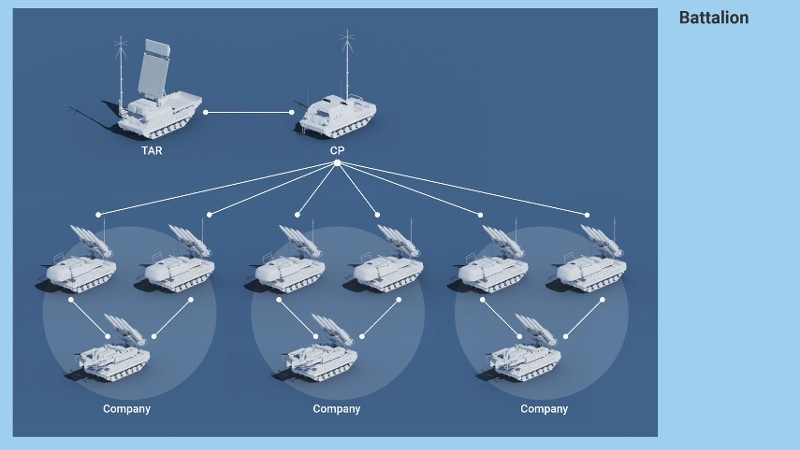
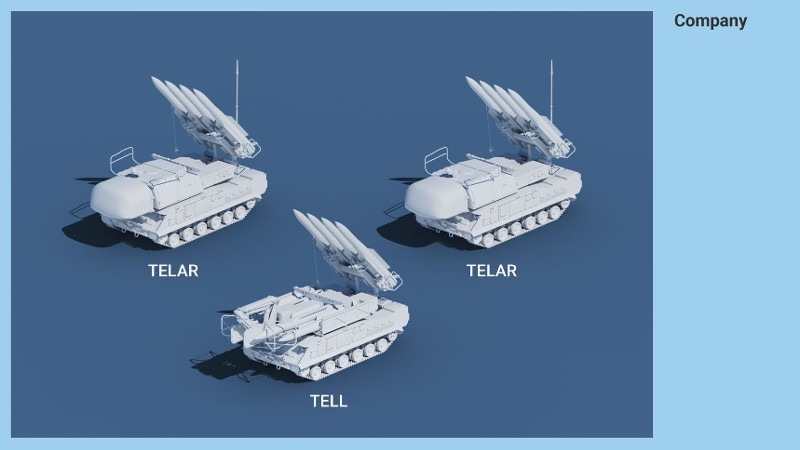
As the court established, MH17 was shot down by a Buk TELAR. Generally, the crew of this weapon system consists of four personnel: a commander, a first and second operator and a driver. The commander is in charge of the vehicle and communicates with the battalion or brigade command. He is the only person on board who is authorised to launch a missile.
In 2014, Colonel Sergei Muchkaev was in charge of the 53rd Brigade. According to Russian military law, as commander he was responsible for carrying out operational missions and keeping track of his units’ position. At that time Muchkaev was under the command of the Chief of the General Staff of the Russian armed forces and the Russian Minister of Defence, Sergei Shoigu. Both are subordinate to the President of the Russian Federation, Vladimin Putin.
That concludes the matter of formal authority, which is not necessarily the same thing as de facto control over the deployment of the Buk TELAR. We will return to this point later. We will begin by focusing on various deployments of the 53rd AAMB in the summer of 2014. With the help of transport orders found in electronic mailboxes of several individuals, including officers of the 53rd AAMB, we were able to gain insight into the movement of equipment and personnel from the Brigade’s base to the border region with Ukraine, at three points in time: from 23 June, 15 July and 19 July 2014. In late September 2014, equipment and personnel were transported back to Kursk. Buk-TELAR ‘3X2’ was part of the first convoy, which left on 23 June. The orders revealed that this convoy took two days to travel to its final destination at the Ukrainian border. Near that location, the Buk TELAR and its crew were picked up in the early hours of 17 July 2014. The next day they were handed over at that same location.
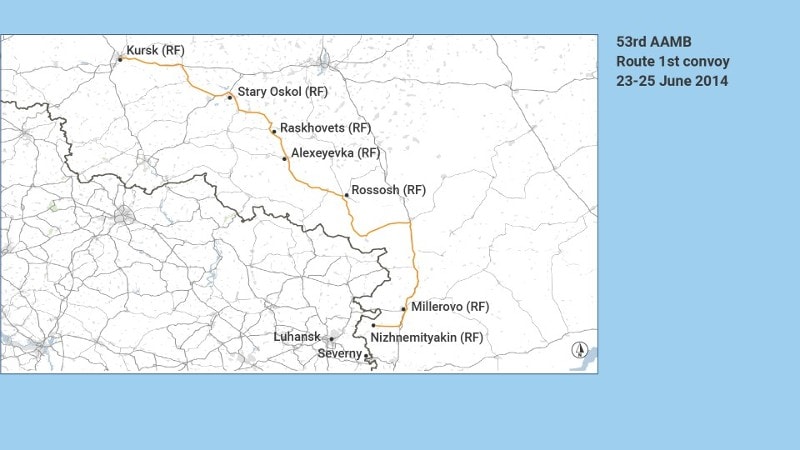
There is a great deal of photo and video footage of this convoy of 23 June. The route described in the orders matches the route shown in this visual material. And the number plates listed in the orders also match the number plates on these images. These images also show six Buk TELARs, complete with vehicle numbers. One of them is Buk TELAR ‘3X2’. The other identifiable Buk vehicles each have a vehicle number beginning with ‘2’. The first digit of the vehicle number refers to the battalion. This means that Buk-TELAR ‘3X2’ came from the 3rd battalion, whereas the other Buk vehicles came from the 2nd battalion.
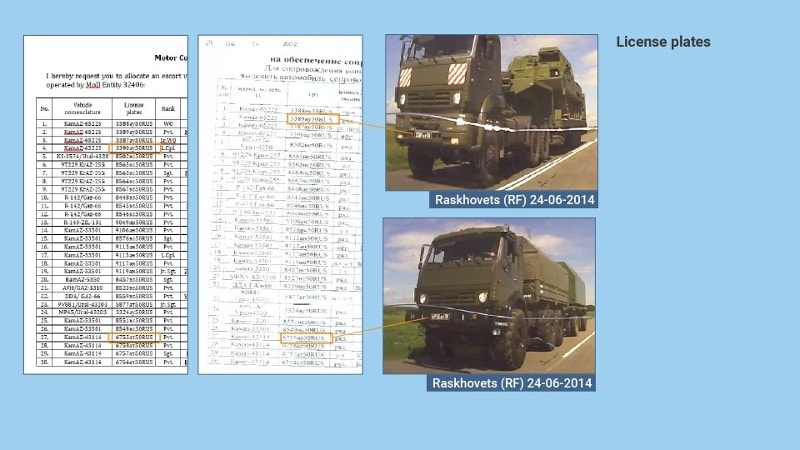
The orders contain no information about the objective of the deployment near the Ukrainian border. A document from 2017 from the commander of the 53rd AAMB refers to ‘strategic exercises on unknown terrain’ in 2014.
On 17 July 2014, the Buk TELAR that shot down MH17 was captured on film multiple times. This visual material reflects what was discussed in intercepted telephone conversations. Images of the TELAR helped shed light on the involvement of Girkin, Dubinskiy and Kharchenko. The last image of the Buk TELAR was captured on the morning of 18 July, in Luhansk.
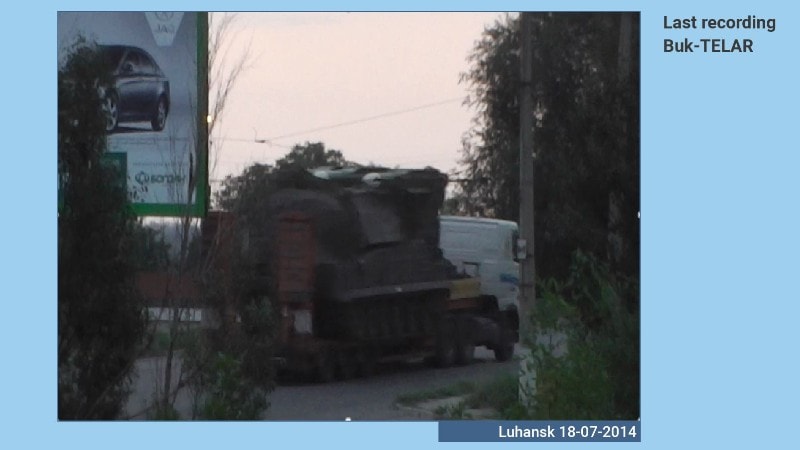
Since images of the TELAR could also shed light on its crew, the investigation also looked into how the TELAR was transported after being returned to Russia: by rail, by road or by air. No indications were found that would point to rail transport. The JIT does, however, have a satellite photo from 20 July taken in the vicinity of Millerovo which shows a single covered vehicle on a low loader. You see that image on the left. The shape and dimensions of this covered vehicle are consistent with the covered vehicles that were observed on a satellite image of the 53rd AAMB’s base shortly before the departure of the 1st battalion. You see that image on the right.
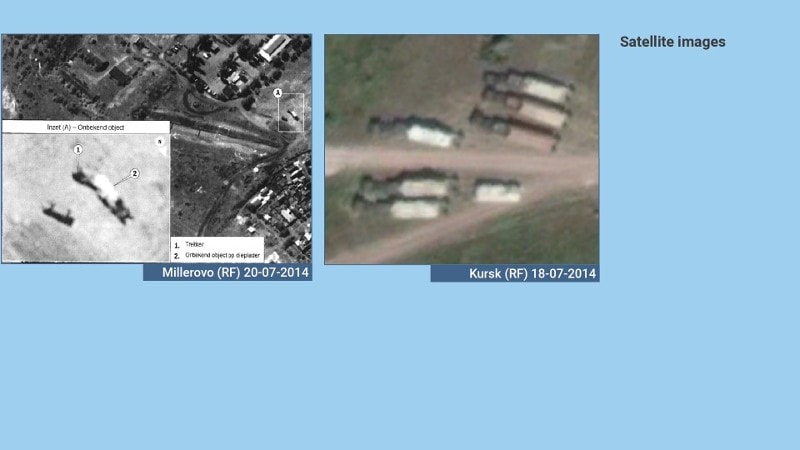
In addition, on 20 July a photo was posted to social media of a covered Buk TELAR on a truck. This truck was also part of the convoy in June that included TELAR ‘3X2’. It could not be determined if one of the images just shown includes TELAR ‘3X2’.
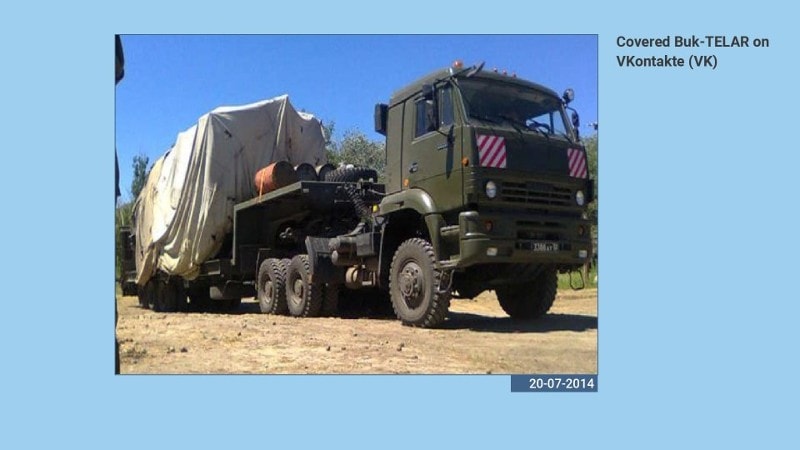
The investigation into the TELAR’s possible removal by air determined that on the morning of 18 July two Ilyushin Il-76s were on stand-by at the nearby military airfield in Rostov-on-Don. An Il-76 is capable of transporting a TELAR. A day later only one of these aircraft was observed there. It was not possible to determine what happened to the other one and whether it was used to dispose TELAR ‘3x2’. At various points on 18 July, starting at 06:08, an Il-76 was observed at the Kursk military airfield, always seemingly at the same spot.
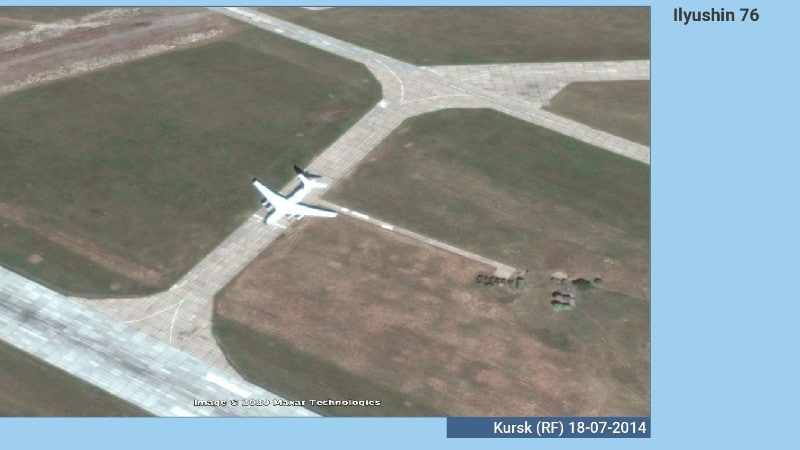
In any case the Ilyushin sitting at this airfield at 06:08 could not be the one from Rostov-on-Don that transported the Buk TELAR ‘3X2’ to Kursk: the ‘3X2’ crossed the border around 06.00 and thus could not have been flown to Kursk by 06:08. It could not be determined for certain if the TELAR ‘3X2’ was transported by air.
In summary, the investigation was unable to establish what happened to the TELAR after it arrived in Russia.
This brings us to the crew. The orders concerning the first convoy, which included Buk TELAR ‘3X2’, contain no information about the accompanying crew. Documents from the second convoy show that as of 15 July at least 193 military personnel belonging to the 53rd were deployed to the same border region. They must have arrived there before Buk TELAR ‘3X2’ crossed the border on 17 July, and for that reason they were included in the investigation of the crew. These 193 individuals were mentioned by name. Most belonged to the 1st battalion, while a smaller number were part of the 2nd and 3rd battalions.
These include members of the staff, such as Commander Muchkaev. Although it is plausible that Muchkaev knew about his brigade’s deployment of the Buk TELAR by virtue of his position, there are no concrete indications of this. Nor is there any telecom data. It is not possible to confirm Muchkaev’s presence in the border region around the time of the downing of MH17. It was not possible to question him during the criminal proceedings because Russia would not allow it.
All military personnel of the 53rd AAMB for whom there were indications that they may have been in the border region when the Buk TELAR was deployed were investigated further. Of that number, 35 officers were considered capable, on the basis of their rank and position, of operating a Buk TELAR. Seven other soldiers were found to have worked as a Buk TELAR operator or as the driver of a Buk vehicle. These findings do not, however, rule out the possibility that there were other officers with the same skills, or operators or drivers, in the border region.
In the course of the investigation a number of current and former members of the 53rd AAMB were tracked down and examined. Those individuals also provided information without knowing that it would end up in the hands of the investigation team. This was the only reason that several of them stated that they had been in Ukraine in the summer of 2014 during their time with the 53rd AAMB. Investigators were unable to confirm this information through direct questioning. One of them said that he was very afraid and unwilling to take any more risks. He was unwilling or unable to say anything about the crew.
There are also chat records involving (former) members of the 53rd AAMB, which point to the presence of a number of military personnel of the 3rd battalion in the Russian-Ukrainian border region in July 2014. They reportedly left separately for a secret destination. These unnamed contract soldiers were under the command of an officer who was mentioned by rank and name. The investigation revealed the identity of this officer. At the time he was a member of the personal staff of the brigade commander Muchkaev. It could not be determined whether this officer was present in the border region on 17 July 2014. Notably, this officer appears in photos on social media after 17 July wearing two military decorations: one for the development of, and combat operations with, a Buk system, and another for extraordinary service with the Russian security service FSB.
Information provided by a witness points in another direction. This witness said to have heard from someone in the Russian army that four people attached to the 53rd AAMB were involved in the downing of the Boeing. These four comprised the crew of the Buk. The witness in question mentions two names. The examining magistrate investigated the witness and determined, on the basis of his or her position, that he or she would have been capable of obtaining this information.
The two names given match those of two officers of the 53rd AAMB. It has been established that at least one of them was deployed in the border region in the summer of 2014. Both were members of the 2nd company of the 2nd battalion.
In an information report by the SBU, one of the officers named by the witness was mentioned as a crew member who had gone drinking with the separatist Tsemakh after the downing of MH17. A witness confirmed this, but did not name the crew member in question. Tsemakh was examined by the JIT on multiple occasions. He disputes having had any contact with the crew, and denies any involvement in the downing of MH17. The investigation yielded insufficient indications pointing to Tsemakh’s criminal involvement.
In summary, a total of three names of officers emerge who may have been involved in the downing of MH17. However, to date the investigation has not been able to find any further confirmation of this. The Russian authorities have refused to answer any questions about the crew, as they maintain that there was never any Russian Buk TELAR in eastern Ukraine.
Finally, on 17 July and 25 September 2022 names and photos circulated on Twitter concerning four members of the 2nd battalion who were said to have shot down MH17. The investigation team obtained the information that formed the basis of these tweets. This includes a 2015 personnel list for the 53rd AAMB, which was already known to the JIT, and passport information. On the basis of this information and the findings of its own investigation, the JIT concluded that there were no indications that these four individuals were involved in the downing of MH17.
We will now consider how the Buk TELAR was supplied to the DPR. The court has established that as of mid-May 2014 the Russian Federation and Ukraine were involved in an international armed conflict in eastern Ukraine because the Russian authorities had overall control over the fighting in the DPR. DPR leaders were in close contact with the Russian Presidential Executive Office, Kremlin advisers and the Russian intelligence services. Staff members of these government bodies also came up in the JIT’s investigation into the decision-making process about the provision of the Buk TELAR to the DPR. The main source for this is telecom data involving both intercepted phone conversations from the case file and new conversations. A number of conversations are mentioned in the report, and we will play excerpts from them shortly.
We will discuss the findings of the investigation in chronological order, starting with the arrival of the Russians Girkin and Borodai in eastern Ukraine in the spring of 2014, in the immediate wake of the establishment of the ‘Donetsk People’s Republic’ (the DPR). On 12 April Girkin crossed into Ukraine from Crimea and was appointed ‘Minister of Defence’. He was followed a short time later by Borodai, who was given the role of ‘Prime Minister’ of the DPR. Both men had previously been involved in the annexation of Crimea, by their own account as advisers of the Russian Sergei Aksyonov, the so-called prime minister of Crimea. While in Ukraine Borodai and Girkin stayed in contact with Aksyonov.
In June 2014 there was heavy fighting between the Ukrainian army and troops of the DPR and other separatists of the Luhansk People’s Republic (the LPR). During this fighting both the DPR and LPR requested heavier weaponry, including better anti-aircraft systems.
For example, Plotnitskiy, the so-called defense minister of the LPR, speaks in Russia in June 2014 with the military intelligence service GRU and asks for heavier air defense weapons to be provided.
Girkin, the minister of defense of the DPR, makes the same request. When his headquarters in Slavyansk, came under fire in early June 2014, Girkin told Aksyonov that they needed ‘decent anti-aircraft systems with trained personnel’.
The investigation carried out shows that from the second half of July 2014 several Buk-TELARs have been delivered to the separatists, including the Buk-TELAR that shot down flight MH17.
The investigation was able to shed some light on Russian decision-making process regarding the delivery of heavier anti-aircraft systems to the separatists.
When Girkin requested for ‘decent anti-aircraft systems with trained personnel’, Aksyonov replied to Girkin that on Tuesday he was where he needed to be given the situation, that a joint coordination centre had been set up, and that the necessary documents for the support were already being drawn up. He said that he still needed to wait because ‘they’ were in different places and would be away for two days.
It is known from another conversation that Aksyonov was in Sochi on Tuesday 3 June. According to the Kremlin, Putin was there on that day as well. On 5 and 6 June, Putin was in France for the D-Day commemoration, together with various world leaders.
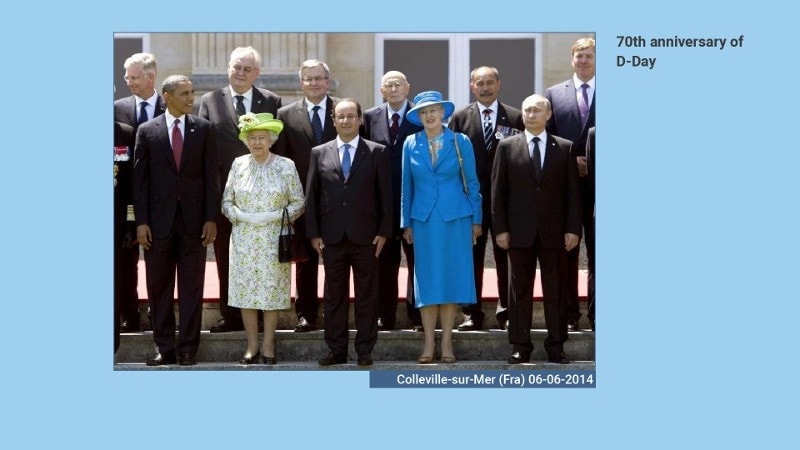
In a conversation of 7 June, Aksyonov’s assistant mentioned that the decision to provide support had been postponed by a week because there was only one person who could make that decision: not a general or Minister of Defence, but the person who was directly accountable to the people and who was currently at a summit in France. We will now play a part of this conversation.
‘Sh…defence minister’ would appear to refer to Sergei Shoigu, the Russian Minister of Defence.
The next day, Aksyonov’s aide took part in a similar conversation, in which he said that his bosses needed another week because there was only one person who could make that decision and who was responsible, and he was in France. We will now play a part of that conversation.
In the second half of June 2014, Aksyonov and the deputy head of the GRU, Alexei Dyumin, requested a political decision on providing the ‘people’s Army’ in Donbas with heavier anti-aircraft systems, such as an S-200 or Buk system. This happened at a meeting at the Presidential Executive Office in Moscow. The Presidential Executive Office is a state body that assists the Russian president; it played an active role in the conflict in eastern Ukraine in 2014. The request by Aksyonov and Dyumin was supported by Vladislav Surkov, an adviser to Putin, and Konstantin Malofeev, an oligarch who was involved in the annexation of Crimea. A contributing factor in this regard is that separatists had previously shot down a large military transport aircraft. Following that incident, the Ukraine armed forces had started flying at higher altitudes. This was why the separatists needed air defences with a greater range.
At this meeting at the Presidential Executive Office a written resolution was adopted to submit the request for heavier anti-aircraft systems to Shoigu and President Putin. The request was granted. It is not known if a Buk system was specifically mentioned in this request.
The investigation showed that the aforementioned meeting at the Presidential Executive Office, in which the participants discussed providing heavier anti-aircraft systems to the DPR, must have taken place between 14 and 30 June 2014. In that period, i.e. from 14 to 19 June, Borodai was in Moscow, as was the separatist Fominov. During their time in Moscow, both Borodai and Fominov spoke in intercepted conversations about meetings and discussions, including a big meeting on 19 June, which revolved around support, believed to be of a military nature, and which was ultimately granted.
In a closed meeting with members of the Duma on 19 June, Shoigu reported that the armed forces were ready to carry out any task given by ‘the leadership of the country and the commander-in-chief’, in other words: by Putin. According to the Kremlin, that evening the Russian Security Council held a meeting on ‘the situation in southeastern Ukraine’. It is not known if the subject of a heavier anti-aircraft system, such as a Buk, was discussed. In any event, a short time later, heavier military materiel, including tanks, was delivered.
And on 23 June a large military convoy departed for the Ukrainian border, including the Buk TELAR which was used to shoot down MH17 on 17 July. To this day, it has not been established whether a decision had already been made before the departure of the convoy about supplying this Buk TELAR to the DPR, or whether this decision was not made until later.
At that time, Surkov, a key adviser of Putin’s, worked at the Presidential Executive Office, where the meeting about air support was held. He is believed to have been put in charge of Donbas affairs in July 2014. According to Girkin, Surkov had the ‘tactical command’ and ‘managed’ ‘the situation in Ukraine in his capacity as adviser to Vladimir Vladimirovich [Putin]’. In an interview, Borodai said that Surkov was the most senior Russian official involved in the matter and that Surkov, as aide to the president, reported directly, and on a regular basis, to Putin. Borodai’s phone data revealed that he was in contact with Surkov nearly every day – and sometimes multiple times a day – except when he, Borodai, was in Moscow. In intercepted telephone conversations, Surkov coordinated a variety of issues with Borodai, such as the encirclement of Slavyansk, the establishment of an additional security service, payments and the intransigent attitude of a DPR commander. In addition, when Borodai sought to coordinate with Moscow about the delivery of refrigerated rail containers containing the bodies of the victims and the black boxes from MH17, his first point of contact was Surkov.
This brings us to the position of President Putin. As we have noted, intercepted conversations revealed that the decision about whether to provide military support lay with Putin. There is also specific information showing that a request to supply the separatists with heavier anti-aircraft systems was submitted to Putin and that the request was granted. Other sources as well point to the president’s personal involvement in the conflict in eastern Ukraine, mainly in a behind-the-scenes capacity. For example, although on 24 June 2014 Putin publicly asked the Russian Federation Council to rescind the resolution that gave him the authority to conduct a military intervention in Ukraine, it remained abundantly clear to the DPR that the Russian president was still involved in the conflict. There are also indications that Putin wished to be briefed in detail about the course of the conflict, for example the downing of a Ukrainian helicopter.
The Ukrainian politician Viktor Medvedchuk also passed on messages from the president with instructions that the DPR must respect a ceasefire. Medvedchuk also spoke with Borodai about an upcoming prisoner swap, in his own words ‘at the request of the president’.
Later, Medvedchuk was mentioned by Putin himself in a conversation with Plotnitskiy, at that time the so-called prime minister of the LPR. On 15 November 2017 Putin was personally briefed by Plotnitskyi about the ‘military component’ and asked him about Medvedchuk’s ‘initiative’ for a prisoner exchange. We will now play the entire conversation.
This conversation from 2017 is in keeping with the findings of late June 2014, which showed that Putin was personally involved in the conflict in eastern Ukraine. It is also in keeping with a witness statement to the effect that the same individual, Plotnitskiy, carried an encrypted phone containing direct numbers for President Putin. As the JIT repeatedly discovered, not everyone was equally disciplined when it came to security of communications.
That concludes the matter of supplying the Buk TELAR. The JIT previously also conducted an investigation into the parties responsible for the deployment of that Buk TELAR on 17 July 2014. Girkin, Dubinskiy and Kharchenko have already been convicted, but the investigation has looked at other individuals as well. One of them is the aforementioned Borodai.
Beginning on 6 July 2014, over a week after the arrival of Buk TELAR ‘3X2’ at the border, changes were made to the military and political structure of the DPR. Russian generals were sent to eastern Ukraine for the purpose of forming a joint staff for coordinating the military operations of the DPR and LPR. It remains unclear how much actual influence they exerted in July 2014. Girkin has said that he did not receive any instructions from this staff.
In the run-up to the offensive south of Snizhne, Girkin regularly conferred with ‘Moscow’. During this period, as well as in June and August, Borodai was in almost daily contact with someone he described to others as ‘the commander of this operation’ and ‘the one who makes all the decisions’. This person has been identified by the investigation team as Andrei Burlaka, an FSB general who was first deputy to the head of the FSB Border Service. The investigation showed that in various cases Burlaka gave orders to Borodai and was directly involved, from the Russian Federation, in internal DPR affairs. Burlaka also gave direct instructions to subordinates of Girkin’s, which Girkin for his part accepted. Burlaka also appeared to have information about the military deployment in eastern Ukraine. For example, on 16 July, Borodai called Burlaka and asked him if it was possible that ‘our helicopters’ were carrying out an attack in the vicinity of ‘Maryinka’. At that point Burlaka asked Borodai to turn on the phone’s encryption mode, as he would always do when the latter called him. We will now play that conversation.
From 14 July there was heavy fighting south of Snizhne between the Ukrainian troops and the DPR. The court has established that the Buk TELAR was deployed in the context of this fighting. The planning and execution of this DPR offensive were in the hands of Girkin, Dubinskiy, Pulatov and Kharchenko, among others. Borodai was also present and was briefed on the DPR’s military progress during the fighting. There are no indications that Borodai was personally overseeing combat operations.
When the offensive stalled and the DPR fighters came under fire, a request was made for a Buk system and that request was granted. When the Buk TELAR was brought into Donetsk on the morning of 17 July, Dubinskiy made arrangements for its deployment. At that moment Borodai and Girkin were also at DPR headquarters. The investigation team was unable to determine whether Borodai was aware at that time of the availability of this Buk TELAR. Borodai did, however, speak to Burlaka on the phone more than 20 times on 17 July. Because these calls took place on encrypted telephones, the substance of the conversations is unknown. No conversations involving Borodai or Burlaka about the downing of MH17, or the request for, delivery or removal of the Buk TELAR were intercepted. Nor is there any evidence that Borodai was in the vicinity of Girkin and Dubinskiy when they were dealing with the removal of the Buk.
Now we will talk about the opportunities for investigation and prosecution. The JIT’s investigation has reached its limits. As things now stand, this leads to the following conclusions:
All relevant and available telecom data has now been analysed. The JIT has investigated everything it can without the cooperation of the Russian authorities and without jeopardising people’s safety. Any further evidence must be sought in the Russian Federation. And for this the JIT is dependent on the cooperation of the Russian authorities or Russian (insider) witnesses. Such witnesses cannot speak freely and would expose themselves to major security risks if they were to talk to the JIT. To this day, the Russian authorities continue to deny – contrary to the established facts – any involvement in the conflict in eastern Ukraine on and around 17 July 2014. On multiple occasions the Russian Federation has provided the JIT with falsified evidence exonerating itself. At other times the authorities simply refused to provide any information. The Russian authorities have also publicly cast doubt on the court’s judgment. Relations with the Russian Federation have deteriorated further since the Russian invasion of Ukraine on 24 February 2022.
The investigation’s findings to date do not provide sufficient grounds for prosecution. There are either formal obstacles to a prosecution, or the necessary lawful and convincing evidence is lacking. We will explain that shortly.
First, let’s consider the crew of the Buk TELAR and their superiors. These military superiors include the commander of the 53rd AAMB, the Minister of Defence and – as commander-in-chief – the Russian president.
Second-hand information was obtained about the possible involvement of three current or former officers of the 53rd AAMB. This information is ambiguous, and thus far it cannot be confirmed to an adequate extent. Since it has not yet been possible to establish the identity of the Buk TELAR crew members, it is not possible to establish why they fired a Buk missile at MH17. Nor do we know who gave them their orders and what those orders entailed. It remains unclear who knew what in the Russian military chain of command about the downing of flight MH17 and what degree of say they actually had regarding it. Prosecution of the crew and their superiors in the military chain of command is therefore impossible because the evidence that has been gathered is not strong enough to be lawful and convincing.
Furthermore, as members of the regular armed forces of the Russian Federation, the crew members and their superior officers may be able to claim combatant immunity. This is a rule of international law that stipulates that countries may not prosecute each other’s military personnel. The immunity continues to apply even after the individual concerned has left the armed forces.
Combatants can be prosecuted for war crimes. However, without concrete information about the circumstances in which the decision was made to fire the Buk missile at MH17, it cannot be determined whether the downing of MH17 was a war crime.
And now let us turn to those responsible for supplying the Buk TELAR.
As the district court held, in the circumstances in question it may be assumed that ‘anyone who helped facilitate the deployment of this weapon’ had both intent and premeditation in respect of unlawfully causing the crash of flight MH17 and the death of everyone on board.
There are strong indications that a decision was made at presidential level, by president Putin, to supply the DPR with the Buk TELAR, or in any event, a heavier air defence system. Although we speak of strong indications, the high bar of complete and conclusive evidence is not reached. Furthermore, in addition to the possibility of combatant immunity, the president of the Russian Federation also enjoys, at the very least, immunity under international law in view of his position as head of state. Under Dutch law, heads of state cannot be prosecuted for any offence whatsoever, even war crimes. This immunity applies for as long as Putin is head of state.
The investigation into the decision-making about provision of the missile produced other names besides Putin, including Aksyonov, Surkov, Dyumin and Shoigu. In the case of Aksyonov, Surkov and Dyumin there are indications that they supported the request for a heavier air-defence system and arranged for it to be submitted to Shoigu and Putin. The question is whether, in doing so, they also have a criminal responsibility for the deployment of this weapon. In any event, they had no actual decision-making power about whether to provide a Buk TELAR. That authority lay at a higher level. In order to determine whether they were sufficiently helpful in facilitating the eventual deployment of the Buk TELAR that their actions constituted criminal aiding and abetting, further and more concrete evidence is needed. There is therefore insufficient evidence as yet to hold them criminally liable for the downing of MH17.
In the case of Shoigu, there is a lack of clarity about whether, as Minister of Defence, he had decision-making power when it came to supplying the Buk TELAR. The investigation mainly found indications that this was ultimately the president’s decision, and not Shoigu’s. This means that there is no concrete evidence for his criminal involvement in providing the weapon that shot down MH17.
Apart from the evidential problem both Dyumin, as deputy head of the GRU, and Shoigu, as Minister of Defence, may be able to claim combatant immunity.
Then there is Borodai: he held various consultations with Russian officials in Moscow about the provision of military equipment. Since it could not be clearly determined whether those consultations concerned the provision of a Buk system, he cannot be held responsible for its delivery.
This brings us to the parties involved in the actual deployment of the Buk TELAR. The investigation did not uncover any concrete instructions given by Russian generals or other Russian officials regarding the deployment of the Buk TELAR.
There were, however, indications of a direct, de facto chain of command between FSB general Burlaka and DPR leaders Borodai and Girkin. It is not clear whether Burlaka was involved in a criminal capacity in the deployment of the Buk TELAR. Since he used a secure line, the contents of his phone conversations are not known. Conversations held by other parties about Burlaka show that his orders to Borodai and to Girkin’s subordinates related to internal conflicts and dynamics among DPR commanders, as well as the provision of equipment. However, nothing was said about providing a heavier air defence system.
Borodai’s role primarily seemed to involve administration, logistics and military support. He made arrangements for support from Russia, but when it came to operational military commands, he would refer people to Girkin. Although he was present at the Girkin’s headquarters that morning and although he was in regular contact with Burlaka by phone on 17 July 2014, the investigation was unable to establish that Borodai and Burlaka had advance knowledge of the availability of the Buk TELAR. Nor could any involvement on his part in the removal of the weapon be established, following the downing on MH17. Therefore, in contrast to the conclusion of the district court in Girkin’s case, it is not possible at this time to provide lawful and convincing evidence that Borodai and Burlaka were able to decide on the deployment and use of the Buk TELAR and that they accepted that deployment and use. Nor is it possible to prove that they deliberately aided and abetted the downing of MH17 in another way.
This brings us to the conclusion of this presentation.
After more than eight-and-a-half years, the JIT has exhausted all scope for investigation. The investigation will therefore now be suspended. Despite the complex context, the JIT achieved a great deal. The findings of the investigation do not provide sufficient grounds for the prosecution of new individuals. This does not mean, however, that the JIT is closing the case. The phone line for witnesses and the MH17 website will remain active, so that any insider witnesses who might wish to tell their story in the future will be able to do so. With this in mind, the JIT agreement will also be renewed. New information or a change in circumstances may give reason to resume the investigation or institute new criminal proceedings.
The bar for establishing individual criminal liability is high. At present we cannot reach that bar for the various individuals discussed, but the picture that the investigation has given us of Russian involvement could play a key role in the state responsibility proceedings. We know that the answers to our questions can be found in Russia. As we have said many times before, solving these kinds of crimes takes patience and endurance. Just consider the Lockerbie case, in which a suspect was recently arrested – after 34 years. In that spirit the JIT remains dedicated to the MH17 investigation.
Thank you for your attention.
